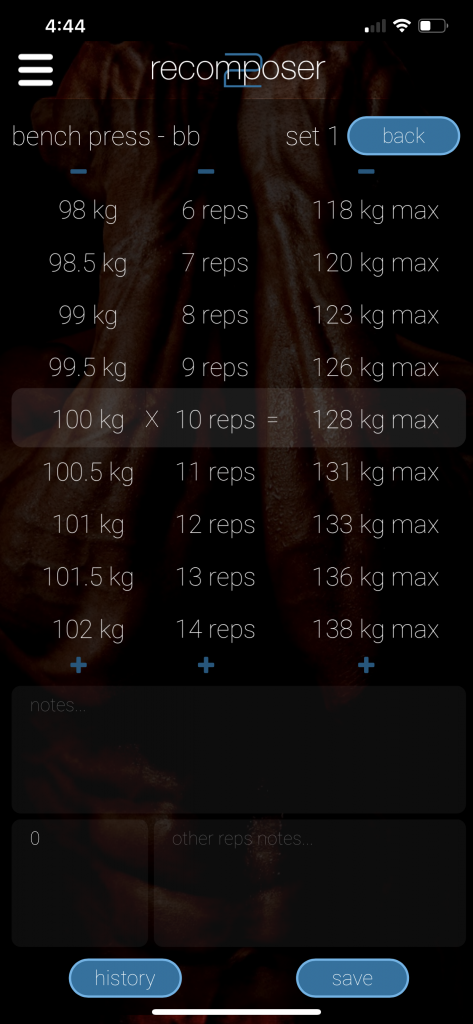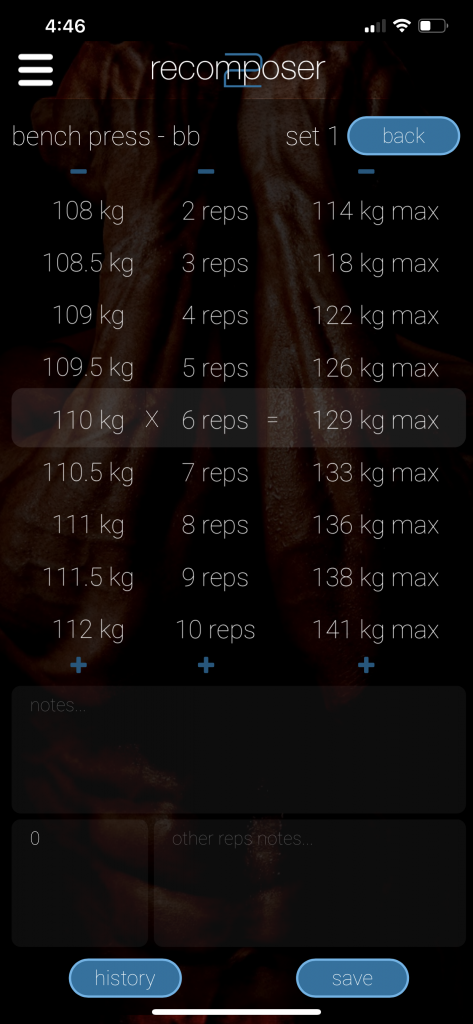Overview
The ‘calculated max’ is a simple, objective way to ‘score’ each set, so you can compare the overall performance of lighter-weight sets for high reps, with moderate-weight sets for moderate reps, and heavier-weight sets for low reps. In other words, it lets you compare sets that would otherwise be incomparable, so you can set goals and assess your progress. Recomposer measures every set of every exercise as a ‘Calculated Max’.
Example Use
Let’s say you managed to lift 100kg for 10 reps on a barbell press. At your next workout you increase the weight to 110kg. Ordinarily you would not know how many reps on 110kg is better, worse or equal to the 10 reps on 100kg? But with Recomposer, your 100kg x 10 reps gives you a 128kg ‘calculated max’. So, before performing your set with 110kg, you would use the rep wheels to find how many reps you need for a calculated max of 128kg or more. In this case, 6 reps with 110kg is a 129kg calculated max; therefore, it is a 1kg better performance than 100kg x 10reps. Note that, as an alternative, you could reduce the weight to 90kg and repeat the process. In this case, 16 reps with 90kg is also a 129kg max; making it 1kg better than doing 100kg for 10reps.
 |
 |
Benefits
Being able to compare different weight and rep combinations allows you to:
- set an objective goal for how many reps you need with any weight, before you doing a set,
- improves focus to make ongoing progress,
- allows for more varied programs (ie a wider range of weights and reps), and
- gives constant, real-time feedback about how well a program is working, or not.
Important
The calculated max weight is purely theoretical. For most exercises, there is no such thing as a practical 1-rep-max. With most exercises, either you can lift a heavy weight for a few good reps, or you cannot do any good quality reps at all. So, Recomposer is absolutely NOT suggesting that you can, nor should, attempt to lift your calculated max. The tiny handful of exercises that suit 1-repetition maximum performances typically require specific training and skill to execute efficiently, effectively and safely.
The purpose of the calculated max is not, therefore, to predict the heaviest weight you could lift. It is to compare sets of different weights and reps, for unparalleled training insight and focus.
Additional Information
- The point of Recomposer and the calculated max is to measure and assess your response to training programming structures/conditions. The goal is to be able to constantly and immediately make adjustments/alterations to your training for maximal progress and the absolute minimum time wasted on ineffective protocols. The calculated max is designed for you and your coach to make more rapid, intelligent and informed decisions about your training. It is NOT a recommendation to use dangerous and dishonest training practices to create a record of false progress.
- It is impossible to improve the calculated max of every exercise at every workout (without using increasingly deteriorating form to claim increasingly terrible reps as ‘quality reps’). For example, consider that a 1kg per week increase to the calculated max of an exercise equates to 52kg of improvement in 1 year. A 52kg gain might be realistically possible on a 500kg Leg Press (a 10% improvement); but the same 52kg gain will definitely be impossible on a 20kg dumbell curl (a 350% improvement). It is incumbent upon you and your Coach to determine which exercises to focus on for progress in each program, and which exercises are not.
- Different training loads and volumes affect people differently. Also, as an athlete develops they will find dramatic changes in the volume, frequency and intensity of training that results in further training progress. Always be wary of Recomposer helps you and your coach measure and quantify what training loads, volumes and frequencies tend to work best for you.
- For all of the above reasons, it is strongly recommended to consult with a coach regularly (weekly or fortnightly) when using Recomposer. The data in Recomposer requires educated interpretation and response to be useful. It was designed for an expert Coach to be able to do their job better. Recomposer is not a replacement for a Coach.
